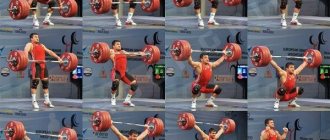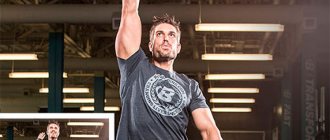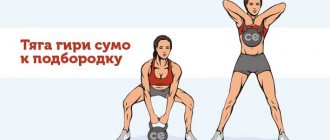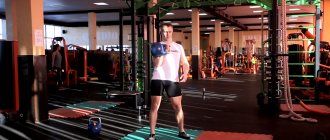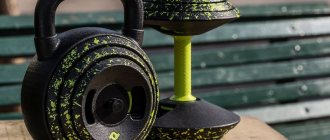Most athletes today build their training program around machines and exercises with dumbbells and barbells, ignoring the kettlebell. This attitude towards the projectile is absolutely unfair. There are exercises that can be performed using a kettlebell, but not with a barbell or dumbbell. A distinctive feature of this sports equipment is its compact size, characteristic grip, and special distribution of loads. For versatile training, the kettlebell is simply irreplaceable and should definitely take its place of honor in the arsenal of every person seriously passionate about sports.
There are two main kettlebell exercises - the clean and jerk and the snatch. Each is worthy of its own article, but today's is dedicated to the latter. Performing a snatch is much more difficult than a clean and jerk. This feature is due to the need to perform one movement - lifting the projectile from the bottom to the top point. The implementation of the jerk takes place without any intermediate stages, unlike the jerk, where the projectile is transferred to the chest and held before the final lift. To perform this movement, you need to have good coordination. All muscles must work harmoniously and connect in a timely manner.
Benefits of the Kettlebell Snatch
- Increases the strength of muscles and ligaments.
- Develops speed endurance, as well as general endurance of the body.
- Improves the cardiorespiratory system by accelerating the heart rate and absorbing large amounts of oxygen.
- Improves grip, joint mobility, elasticity of muscles and ligaments.
- The exercise not only develops muscle volume, but also, due to the high intensity of execution, can burn subcutaneous fat.
Important! Proper breathing plays a huge role in the snatch. Under no circumstances should you hold your breath, otherwise the body will not have enough oxygen to perform the exercise efficiently and safely.
At the fixation point, you can perform several breathing cycles (inhale-exhale) if you need to restore strength.
Example workout
Kettlebells are convenient because they take up very little space, so you can exercise with them both in the gym and at home.
We start each workout with a warm-up; this is necessary to prepare the muscles, avoid injuries, and warm up the ligaments and joints.
We stretch the neck by tilting the head back and forth and left and right. We swing our arms, rotate our forearms and hands. We squat two sets of 10-15 repetitions, do hyperextension two sets of 10 times. We lean forward, backward and left and right.
Beginners need to start training with exercises:
- Squats with kettlebells.
- Mahi.
- Pulls to the chin.
- Kettlebell press.
This will strengthen the muscles of the arms and back and prepare the body for correct movements during the snatch and push. Experienced athletes can use the listed exercises as warm-ups.
Example workout for beginners:
- Warm up.
- Squats with a kettlebell in front of you, 3 sets, 20 reps each. Girls just need to take 16 kilograms with both hands in front of them. For men, squats with two 16 kg weights on the chest are suitable.
- Kettlebell swings – 3 sets of 20 reps
- Rows to the chin – 3 times 20 repetitions
- Press – 3 sets of 10-15 reps.
Example training for experienced athletes:
- Warm up.
- Squats holding a weight above your head for 30 seconds on each arm.
- Swings with changing hands – 2 minutes.
- Snatch – 2 minutes with each arm.
- Hold 2 weights on the chest – 2 sets of 1 minute.
- Chest push – 2 minutes per arm.
- Chest cleans – two minutes with each arm.
This workout can be done both in the gym and at home.
In the gym, exercises with kettlebells can be combined and included in bodybuilders’ training complexes to develop endurance, speed and coordination. For example, after leg training, perform kettlebell swings 3 sets 15-20 times.
If these workouts seem easy to you, simply increase the intensity of the lifts or add a minute to each set.
Approaches and repetitions algorithm for compiling a training complex
- Determine your maximum - perform the exercise to the limit, and remember the number of repetitions.
- Build your workouts based on this maximum, performing 60-80% of the previously established maximum repetitions in each working approach.
- Rest between working approaches from 2 to 5 minutes. During this time, you need to completely restore your breathing.
- Gradually increase the number of repetitions each workout. Watch your health, don't overdo it.
The number of working approaches when working out with weights ranges from 2 to 5. The number of repetitions will depend on your fitness, but should not be less than 15. Before starting each new exercise, do 2 warm-up approaches of 6-10 repetitions each.
What weight to take: 4, 8, 16, 24 or 32 kg
Choose the weight based on the number of repetitions; if you can’t do 15 repetitions, then the weight of the projectile needs to be reduced.
For young people, it would be wise to start with 16 kilograms for two-arm movements and 8 kilograms for one-arm movements. If the young man is well physically developed, you can start with 16 kilogram weights.
It is better for beginner girls to try with a 4 or 8 kilogram weight, depending on their preparedness.
First of all, hone the correct technique and only then increase the load. When training with kettlebells, it is not necessary to increase the weight of the apparatus each time. It is enough to increase the intensity of movements.
Where to start for a beginner
Before starting a workout, you need to thoroughly warm up your muscles and joints . Be sure to stretch your muscles before and after exercise. Stretching will allow the muscles to remain flexible and elastic, which will further prevent injuries such as sprains and tears.
It is necessary to develop grip strength so that the hands do not get injured during jerking movements or even slow down progress in the exercise due to weakness of the ligamentous apparatus. Train your forearm along with your major muscle groups. Perform basic multifunctional exercises to develop strength not only in muscles, but also in ligaments.
To begin, practice snatches with light weights. Don't do the exercise for a while. Poor technique at high speed will not develop accuracy of movements, and in the future increasing the weight of the kettlebell will be impossible and very dangerous.
Work on your technique in the presence of a professional. Only after honing the correct movements, start working on speed, that is, a large number of repetitions in a short period of time.
What muscles are involved?
This workout is complex. Accordingly, the athlete works out different parts of the body. What muscles work during a snatch:
- abdominal muscles (oblique and rectus);
- gluteal;
- brachialis clavicular muscle;
- infraspinatus
The deltoids, calves, latissimus muscle, and forearms actively participate in the movements. If you hold the sports equipment closer to the body, the load on the muscles will be reduced. As this distance increases, more effort will be required to complete the movement. When mastering the technique, it is preferable to use the first of these options; for a more experienced athlete, the second method of execution may become attractive.
Snatching not only makes your muscles stronger, but also helps develop their endurance. The trapezius and deltoid muscles receive maximum load, contributing to the active development of the shoulder girdle. Performing a snatch has a positive effect on the development of the entire group of spinal extensor muscles and the muscular corset as a whole. In order for this exercise to be as effective as possible, it is important to strictly follow the technique of movements.
One-handed kettlebell snatch technique
- Place your feet hip-width apart and turn your toes apart. Bend over and grab the handle of the weight with your hand.
- Keep your back straight. Bend your body by bending your knees.
- Swing your arm under your pelvis so that the weight passes between your thighs and under your buttocks.
- When swinging the weight forward, push with your pelvis and thigh so that your hands do not apply force to the swing, and the weight flies up from below by inertia on straight arms.
- At abdominal level (in the middle of the movement), perform a lift using the strength of the shoulder, moving the body slightly back. Undermining brings the weight back into a state of “weightlessness” to the top point - the weight is above the shoulder.
- At the top, straighten your elbow, but bend your knees into a squat position. The weight, describing a circle, rests on the forearm.
- When fixing, straighten your legs, keep your elbow and knees straight. The hand holds the arch with an underhand grip. The inner side of the palm is turned outward.
- Keep your arm above your shoulder joint, forming a straight line with your body.
- During the reverse movement, drop the weight with a straight arm, relaxing the shoulder muscles. The weight flies along the same trajectory, without a jerk; at the lowest point, bend over and pass the weight between your thighs. And again jerk up, using the pelvis and hips.
- Do the required number of repetitions, then in the air while swinging, change the grip of the arm to the other hand, and perform the same number of jerks.
- At the end of the exercise, place the kettlebell on the floor.
Benefits and harms
Kettlebell lifting develops such useful qualities as:
- Strength – your grip strength will noticeably increase, your arms and shoulders will be stronger, and you will be able to work more effectively on the mass.
- Speed – exercises with kettlebells are dynamic and require sharp muscle contractions, which allows you to increase speed characteristics.
- Coordination – when lifting this projectile, the whole body works, and a person learns to control it more effectively.
- Development of the core muscles - in order to lift and hold a kettlebell above your head, you work your abs, back and many small stabilizer muscles.
- Endurance – due to the fact that almost the entire body works at the same time, the load on the cardiovascular system and breathing increases.
- High energy consumption - when working with weights, a lot of calories are burned, which means that such exercises, together with proper nutrition, are effective for losing weight.
- Strengthening ligaments and joints - kettlebell lifting has a beneficial effect on the elbows, wrists, shoulder joints and strengthens the spine.
Harm from exercise is possible if an athlete chooses too heavy weights for training or begins to perform complex exercises without prior preparation and practicing the correct technique. Injuries very often occur in unprepared people with underdeveloped muscles.
Exercise space and equipment
The greatest advantage that weights can give is the ability to exercise at any convenient time, as well as in any convenient place. If regular bodybuilding requires a lot of space and a lot of equipment, then for the sport in question you only need weights. In order to perform exercises such as kettlebell snatches, it is recommended that beginners purchase 16 kg equipment.
Over time, the athlete's strength and endurance will increase, and to perform the exercise it will be necessary to change the equipment to heavier ones. First, the weights change from 16 kg to 24 kg, and then from 24 kg to 32 kg.
You can purchase such equipment at a sports store. If you want to save money, you can buy weights from friends or secondhand (for example, through advertisements). In this case, the price will be much lower. There is no difference between the shells, since their appearance and characteristics have remained unchanged for decades.
Squatting and fixing the weights on a straight arm
After inserting the hand into the arch, a slight squat and straightening of the arm follows. Squatting and straightening the arm are done at the same time. Squatting is not necessary , it depends on individual technique. You can move your hand straight up to your straight legs. Usually they lift the weight on straight legs, and begin to squat against the background of fatigue.
In the fixation position, the body is fully straightened, the hand is next to the head ( frame 6 ). The overall center of gravity is at the full foot. If possible, you need to relax your legs and triceps as much as possible while holding the kettlebell.
Features of kettlebell lifting and advantages
Kettlebell lifting has several important features. The first of them is the rapid development of the athlete’s strength characteristics and, mainly, an increase in his strength endurance. The second feature is that it is one of the few sports that uses muscle groups throughout the body. At the same time, all movements with a kettlebell, from the point of view of technical execution, are not considered difficult.
One or two lessons are usually allotted to fully master the technique. Thanks to such fast learning, it is possible to start full-fledged training after just a few lessons.
The main advantages of this sport, of course, include the fact that you can perform the exercises almost anywhere, and the benefits from the exercises are colossal. In addition, a child who has reached the age of 13 or 14 years can engage in kettlebell lifting. With the help of exercises with such equipment, you can quickly develop strength and endurance in a teenager, as well as improve his general physical fitness, which is quite capable of increasing his performance. Due to the nature of this sport, success in it is measured not by the maximum weight of the weight that the athlete can lift, but by the number of lifts.
Endurance development
There are two types of endurance, each of which can be developed by kettlebell lifting. The first type is strength endurance. To lift something heavy, a person needs developed strength. But in order to move a heavy object, it is strength endurance that is required. It is quite simple to develop this indicator by doing a kettlebell jerk. The muscles involved in this exercise will develop not only in terms of strength, but also in terms of endurance. In addition, as strength indicators increase, a person’s overall endurance will also increase. For this reason, kettlebell lifting is recommended for runners and swimmers.
It is worth noting that you can develop strength endurance or general endurance without giving up your chosen sport. The kettlebell snatch or swing exercise can be done on a free day from training. Twice a week will be enough to develop strength and endurance.
Resetting the weight from the fixed position
After fixing the weight on your straightened arm, you need to rotate the weight around your forearm, move your arm forward, slightly bending it at the elbow, and tilt your body back slightly ( frame 7 ). After this, immediately at head level, you need to intercept the bow with an overhand grip ( frame 8 ), slightly raise your shoulder and stand on your toes. And starting from this moment, begin to reduce the speed of the weight. At the moment when the arm becomes tense from the weight, you need to slightly extinguish the twitching movement by lowering the shoulder and begin to bend a little at the knees ( frame 9 ).
Technique
The technique for performing this exercise is not too complicated, but it requires thorough knowledge and strict adherence. Otherwise, injury may occur.
- The position that is the initial one, that is, the starting position, is identical to the one that the athlete occupies when performing the swing exercise.
- The further movement also resembles the movement in a swing, that is, it is necessary to raise the projectile to chest level. However, in a jerk it will be necessary to push the projectile even further.
- In order to successfully bring the weight to the required level, it must initially be given the correct lifting trajectory. Plus, at the moment when the projectile reaches the chest, it is necessary to apply additional force and at the same time carry out a slight squat.
- At the moment of performing the squat, the athlete should begin to turn the hand with the weight towards the forearm. A correctly performed squat ends with the athlete leveling out, and the weight already resting on the forearm and hand.
- In order to complete the exercise, you must return to the starting position. In this case, the weight must be returned through the back of the hand. To do this, the athlete must turn his hand towards himself during the movement.
What are the benefits of kettlebell lifting?
There are only 3 main exercises in this sport - swings, pushes and jerks. All these movements with apparatus develop the athlete’s dexterity and also affect the health of his joints. Due to the peculiarities of performing such exercises, people involved in this sport feel good about their body. In addition, all movements used in kettlebell lifting are similar to those that a person performs in everyday life. It is for this reason that kettlebell snatches, swings, or cleans will help an athlete better cope with everyday chores around the house.
Conclusion
Training with kettlebells will harmoniously develop all the muscles of the body, improve coordination, and make you strong and resilient. Such exercises are very energy-intensive, and by doing them every day, you will lose excess weight and become slimmer and more graceful. But before you rush into battle, carefully study the correct technique and do not make gross mistakes.
If you liked the article, share it on social networks and subscribe to our VKontakte and Telegram groups. There you will learn how to quickly get your body in shape and lose weight.
The influence of kettlebell lifting on humans
The main impact of an exercise such as the 16kg kettlebell snatch is primarily on forearm strength and grip strength. These indicators are very important, since a strong grip is the key to success in some other exercises. For example, when doing pull-ups, it is very important to have developed forearms, since a lack of strength will not allow you to fully develop the capabilities of other muscle groups. This means that the number of repetitions in other exercises and their effectiveness will drop noticeably.
Eight
Want to pump up your core muscles? Then feel free to include the element in your program! In addition to the core muscles, the legs and arms work here. The essence of the element is to describe a figure eight around the legs with the projectile, for which you need:
- Place your feet slightly wider than your shoulders and take the weight in your right hand.
- Bend slightly forward with your knees bent and your back straight, bring the projectile between your legs a little further than your torso.
- Reach back with your other hand and take the weight from your right.
- Move the limb with the projectile forward and bring it back between your legs.
- With your right hand from behind, grab the kettlebell again.
The exercise perfectly develops coordination of movements, and it looks very impressive.
Rise from the main start to the explosion
After the kettlebell begins its return movement from the main start ( frame 1 ), you need to start moving your pelvis and knees forward, as if slightly ahead of the movement of the kettlebell, thereby giving the weight an initial acceleration ( frame 2 ). At the same time, the overall center of gravity smoothly shifts closer to the toes
After passing the weights of your knees, begin to squeeze your buttocks and straighten your legs (open up). And, as if to counterbalance the weights, tilt the body a little back ( frame 3 ).
You can read more about this part of the movement in the article by Sergei Rudnev - Kettlebell swings, types of swings and execution technique.
Joints in kettlebell lifting
Every athlete knows a simple truth - you cannot use a muscle without using a joint. So, in kettlebell lifting, like in any other, a large number of joints are involved. However, there is a slight difference. When performing any exercises, the joints work in turn, since the technique is divided into several parts. There is no such thing in the kettlebell snatch. This means that all the joints that are involved in the work do so almost synchronously.
On the one hand, this is good, since in this case the load is distributed over several areas, each of which in some way insures the other. However, this is the problem. If the movement technique is violated, there is a high risk of causing serious injury to oneself, which will affect many joints at once. It is for this reason that experienced coaches and athletes say that in kettlebell lifting technique is above all else. You cannot work “to failure”, as in bodybuilding. You need to do a little at a time, studying the technique of performing the selected exercise with the apparatus.
Lowering the kettlebell to the main start position
The last phase of the movement remains. The kettlebell is slightly in front, the arm is fully straightened, the elbow is pressed to the body, the overall center of gravity falls more on the toes ( frame 9 ). After this, we begin to lean forward ( frame 10 ), and move the pelvis and knees back until the weight stops completely. And now you have arrived at the original position ( frame 1 ). Then everything goes in cycles and repeats itself many times.
If you breathe incorrectly, then there is no point in the technique. All the movements described are closely combined with proper breathing. Also in the opposite direction - any deviations in the jerk technique lead to disruption of the breathing rhythm, which leads to oxygen starvation and premature fatigue.
There are 2 main breathing options:
- two breathing cycles for jerking and lowering the weights
- three breathing cycles for jerking and lowering the weights





